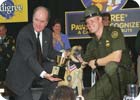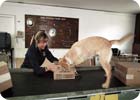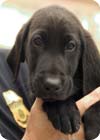Will Work for Dog Food

U.S. Customs and Border Protection Commissioner Robert C. Bonner and CBP Border Patrol Agent Clay Thomas receive the Paws to Recognize tribute to working dogs for “Jacko,” a concealed human and narcotics detector dog.
Forever, dogs have provided guard and detection services. Popular with government and military operations, about 6 percent of private security use so-called K-9 teams, according to recent Security Magazine research. And use is increasing. Studies show a barking dog is the best home security strategy.
And while high technology homeland security solutions grab headlines, explosive detection K-9 teams remain the gold standard among all deployed explosive detection systems because the sensitivity of a trained dog’s nose is superior to virtually all current generation devices. The dog’s detection limit sensitivity is estimated to be between a few parts per billion to 500 parts per trillion. Just as important, the canine’s nose is capable of locating explosives spatially, which permits rapid searches of large areas.
Canines are able to distinguish the presence of explosives in complex environments and are significantly less susceptible to scent masking problems. By way of example, radiation portal monitoring devices can be set off by containerized products that give off ionizing radiation, such as kitty litter, bananas, potting soil, broccoli and bagged concrete; trained K-9s wouldn’t sit on such items.

Training of a detection dog, or to a lesser extent a security patrol dog, is an expensive investment but it can create a significant payoff.
PUBLIC RELATIONS PLUS
A K-9 team is also good for public relations, both as a powerful symbol of public safety and a strong deterrent to the bad guys. A canine team can do the work of as many as four officers with portable explosive detection devices or ETDs and is superior to every other technology for the detection of explosives. The soon-to-be-rolled out TWIC (The Transportation Security Administration’s $70 million contract to deploy the Transportation Worker’s Identification Card) may be a deterrent to terrorist’s intent on bringing explosives into seaports and airports.Although a canine will never ask its handler for a raise, there are some challenges involved with them. Cost is one problem, especially if you opt to deploy well-trained teams with dogs from top detection bloodlines. We invested over $26,000 per team for tuition, detector dog, room and board, travel and handler wages to train our K-9 teams and procure top detector dogs at the Auburn University Canine Detection Training Center, which trains K-9 teams for the U.S. Coast Guard, Federal Protective Service, numerous law enforcement agencies and SecureTrans, LLC.
Our annual costs for dog food, veterinarian care and handler mileage exceed $4,000 per team, excluding handler salary and benefits. While some critics point out that detector dogs become quickly fatigued, after using them through a full Alaskan cruise season at the Port of Seattle, as well as on other critical infrastructure assignments during the year, we don’t feel that this a significant problem.
Dogs are highly persistent and consistently eager to work and have only required a break period to rest and play for up to 30 minutes about every one or two hours. But cruise ship passenger and baggage screening experience demonstrates that human checkpoint x-ray machine operators actually need to be rotated away from their positions after only about 20 minutes of staring intently at their screens. There is also the human element—distractions, conversations with peers, etc. But when they are working, detection dogs remain focused on the job, and a good handler concentrates intently on his or her four-legged pal.
NOT FOR SOME JOBS
From an administrative standpoint, it’s true that it is more complicated to manage and schedule K-9 coverage than to do the same for ETDs, because K-9 coverage is so mobile—its virtue and its challenge. That is countered by scheduling teams for a minimum of four hours (including breaks) at any one client site, and by furnishing our handlers with a Nextel phone and a pager.A further thought: Detector dog teams are not particularly useful for in-line checked baggage screening applications, because the lines are designed to operate speedily and several teams would be necessary to keep the line moving when a dog exhibits fatigue and needs to be rested. However, they are a suitable alternative to having an ETD operator rub bags with swabs to detect explosive residues, because they can sniff the baggage much faster than the ETD system and its operator can work. Their throughput is much faster.
Actually, this author doesn’t believe that detecting trace amounts of explosives is a useful enterprise. As security professionals, our great concern should be with explosives in quantities sufficient to make a bomb. K-9s are particularly good at this task, as it is the essence of their training and is what they most enjoy doing.

Most training starts with a puppy and they have great noses.
SIDEBAR: A Final Word on Comparative Costs
According to the GAO, the TSA deployed a total of 6,246 ETD machines in 2006 at a procurement cost of $40,000-$50,000 each (approximately $281,000,000) with annual maintenance costs averaging $10,300 per machine (approximately $64,000,000). This cost does not include the TSA operator expense.The annual cost of fielding a K-9 team (approximately $56,000) appears to be higher than that because of the compensation of the handler, until one factors in the operator cost.
Of course, cost is not the primary concern when the objective is to establish the best possible threat assessments. That’s why TSA has developed a multi-faceted security program involving electronic instruments, K-9 teams, human stress recognition training and a variety of other methodologies.
Looking for a reprint of this article?
From high-res PDFs to custom plaques, order your copy today!




